Tarantulas are fascinating animals that come in a wide variety of shapes and sizes. There are over 800 unique tarantula species, so there’s a lot of diversity when it comes to these interesting arachnids.
Some of these spiders are quite tiny, but others grow to gargantuan sizes of over 11 inches!
With so many different species it can be difficult to determine which ones are right for your tarantula collection. If size is what you’re after, you’ve come to the right place, because today we’re going to rank the top 10 biggest tarantula species in the world!
Top 10 Biggest Tarantula Species
1. Theraposa Blondi
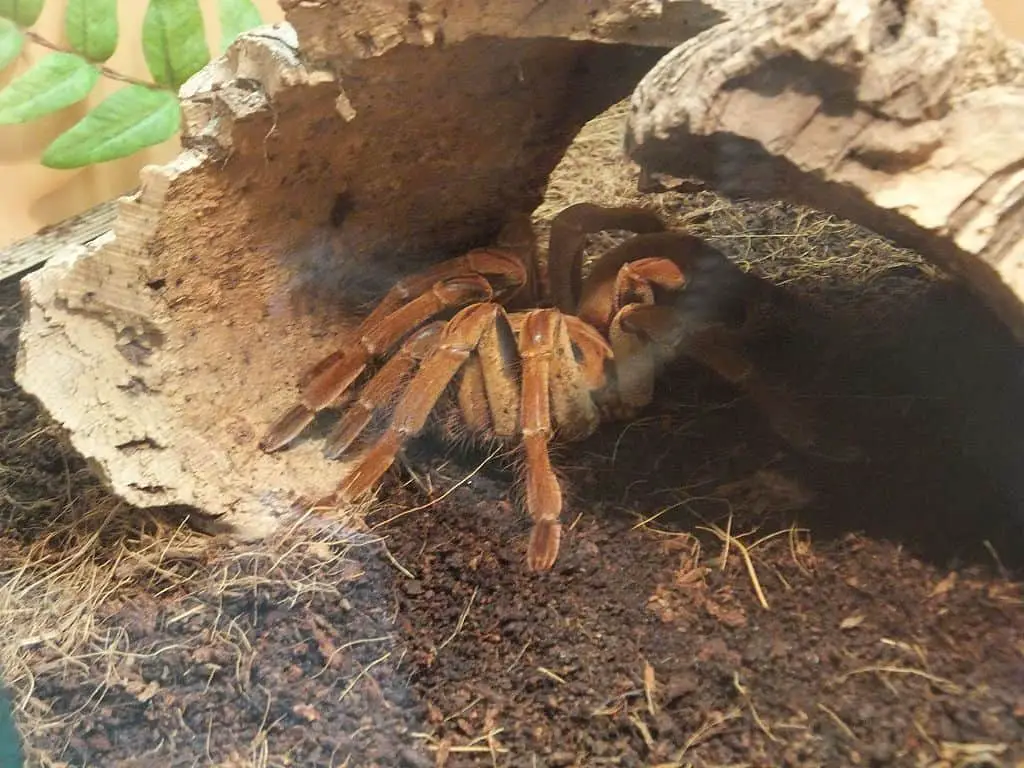
| Category | New World |
| Type | Terrestrial |
| Leg span | 11 inches |
| Growth speed | Fast |
| Lifespan | Female: 25 years / Male: 5 years |
| Experience level | Advanced |
The Theraphosa Blondi, better known as the Goliath Birdeater, is a New World Terrestrial tarantula. It’s the undisputed king of the spiders. They’re not only the largest of the tarantula species, but they’re also the largest spider by weight. In leg span, they only get beaten by the Giant Huntsman.
Fully grown, this spider can have a leg span of up to 11 inches, and a body length of around 4 inches.
This spider is not suitable for beginners though, since they’re quite nervous and don’t require much provocation in order to show a threat posture or flick their urticating hairs.
In addition, they have very big fangs and are not afraid to use them. Their venom might be weak, but they can do quite a bit of damage with their sharp fangs regardless.
However, if you’re an experienced hobbyist, the Goliath Birdeater is a must-have for any serious collector. Not only because of their size but also because of their stunning appearance, interesting behavior, and strong feeding response.
2. Theraphosa Apophysis
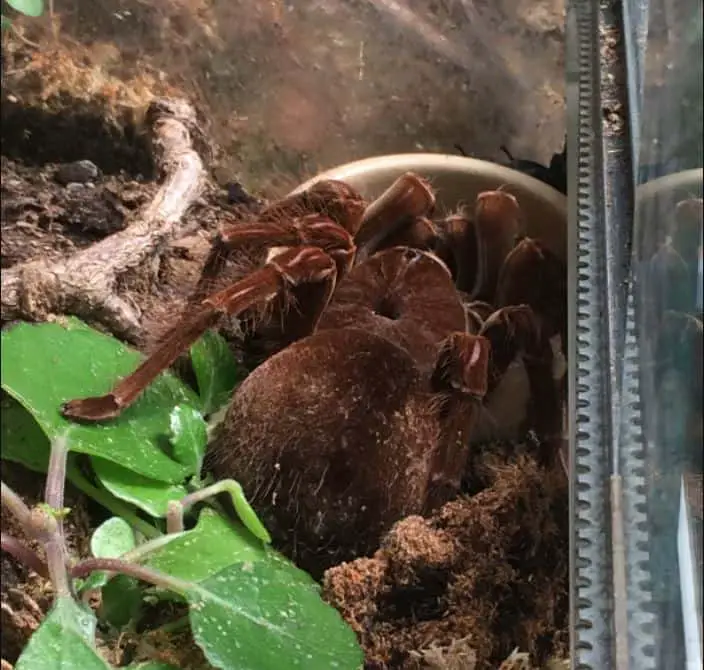
| Category | New World |
| Type | Terrestrial |
| Leg span | 11 inches |
| Growth speed | Fast |
| Lifespan | Female: 25 years / Male: 5 years |
| Experience level | Advanced |
The Theraphosa apophysis is commonly known in the hobby as the Pinkfoot Goliath Birdeater. They’re in the same Theraphosa genus as the T. Blondi and are about the same size as them, though typically slightly smaller.
This bulky spider tops out at a size of around 11 inches in leg span, and 4 inches in body length, and is very similar in behavior to the T. Blondi. Both are quite defensive, very fast, and have powerful fangs.
The primary difference between these two species is that the T. Apophysis is hairier and has a pink coloration at the end of its legs as a sling and juvenile. As adults, however, this coloration disappears and they’re very hard to distinguish from the T. Blondi.
In addition to their large size, these spiders are also highly desired for their long lifespan. Females can live for up to 25 years in captivity!
3. Theraphosa Stirmi
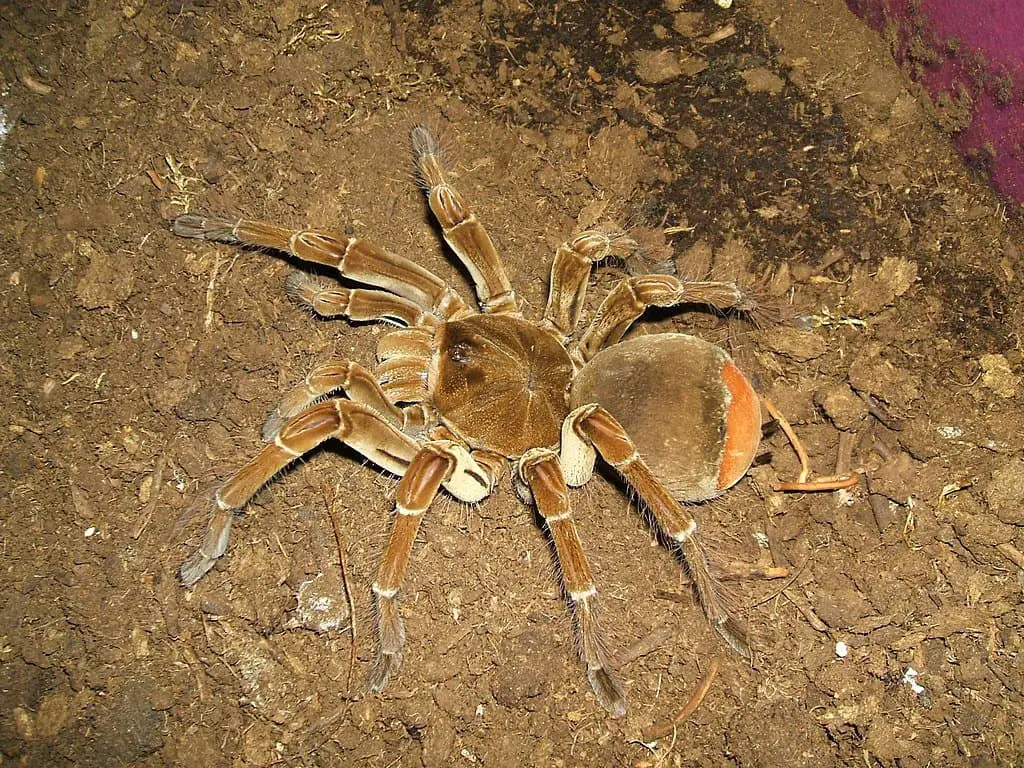
| Category | New World |
| Type | Terrestrial |
| Leg span | 10 to 11 inches |
| Growth speed | Fast |
| Lifespan | Female: 20 years / Male: 4 years |
| Experience level | Advanced |
The Theraphosa Stirmi, also known as the Burgundy Birdeater Tarantula, is the final species of the Theraphosa genus in this list. They’re very similar to the previous two species, so there’s not all that much else to say about them. They’re almost equally big, equally defensive, and equally fast.
The main difference between this species and the other two is the coloration. For the rest, the care and characteristics are much the same. Nevertheless, this list would not be accurate if we left this species out!
4. Lasiodora Parahybana
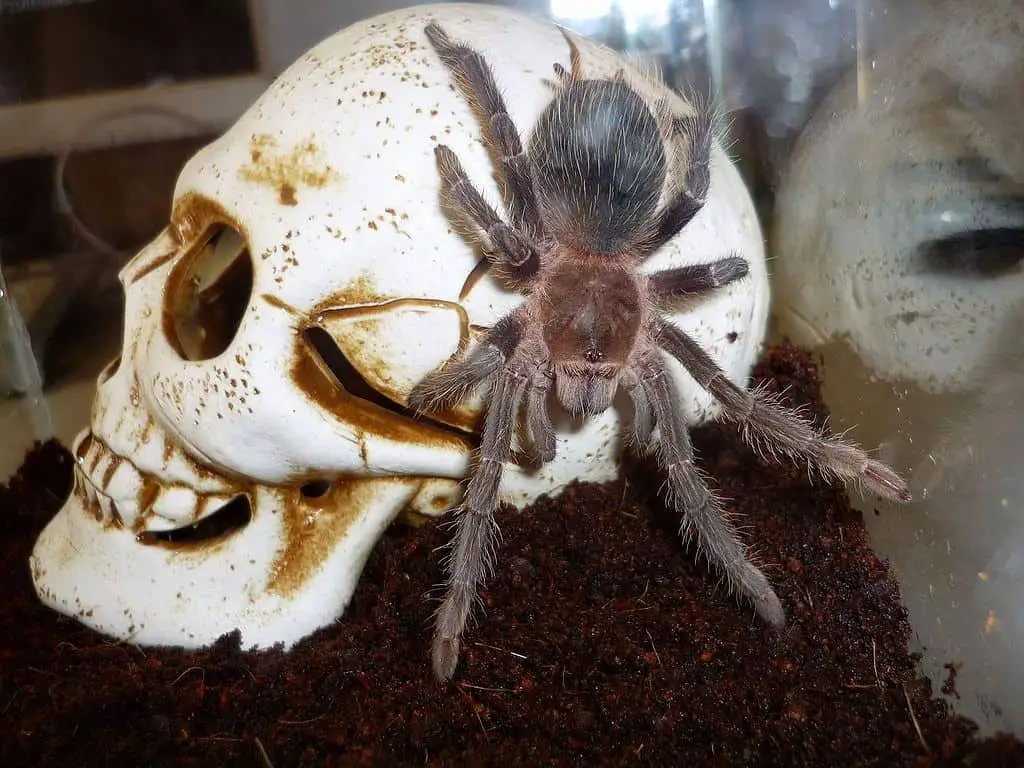
| Category | New World |
| Type | Terrestrial |
| Leg span | 10 to 11 inches |
| Growth speed | Fast |
| Lifespan | Female: 15 years / Male: 5 years |
| Experience level | Beginner |
The Salmon Pink Birdeater, known scientifically as the Lasiodora parahybana, is a very large New World tarantula species that tops out at a leg span of slightly under 11 inches.
Besides their large size, they’re also known for the pinkish hairs on their dark abdomen and legs.
In addition, this species is quite docile. They’re not very defensive and they tend to try to flee rather than fight when they perceive something as a threat.
On top of that, the Salmon Pink Birdeater tarantula is not particularly shy and tends to spend quite a bit of time out in the open. This, combined with its docile nature makes it a great species for beginners who want a huge tarantula.
On top of that, they’re also quite cheap, making them even more accessible for beginner hobbyists.
5. Poecilotheria Rufilata
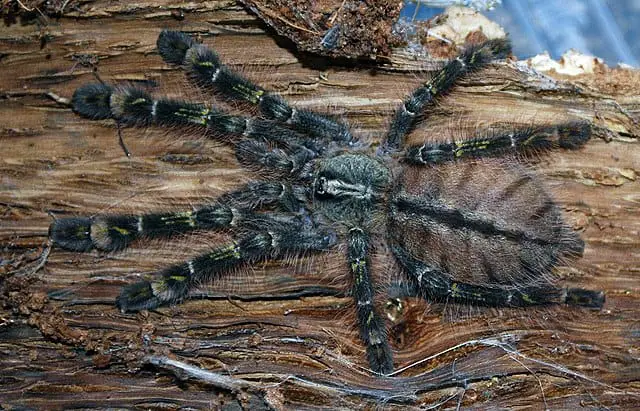
| Category | Old World |
| Type | Arboreal |
| Leg span | 9 to 10 inches |
| Growth speed | Fast |
| Lifespan | Female: 11 to 12 years / Male: 2 to 3 years |
| Experience level | Advanced |
The Poecilotheria rufilata, also known as the Red Slate Ornamental Tarantula is the first Old World tarantula on this list. Topping out at a leg span of around 9 to 10 inches, this arboreal spider is native to India where it lives in the trees.
They also have quite an interesting appearance, with beautifully colored markings on their carapace, legs, and abdomen.
While beautiful, this species is not very suitable for beginners. They’re lightning-fast, have potent venom, and are quite defensive.
As a display spider for experienced keepers though they’re an absolute beauty to behold and highly recommended.
6. Poecilotheria ornata
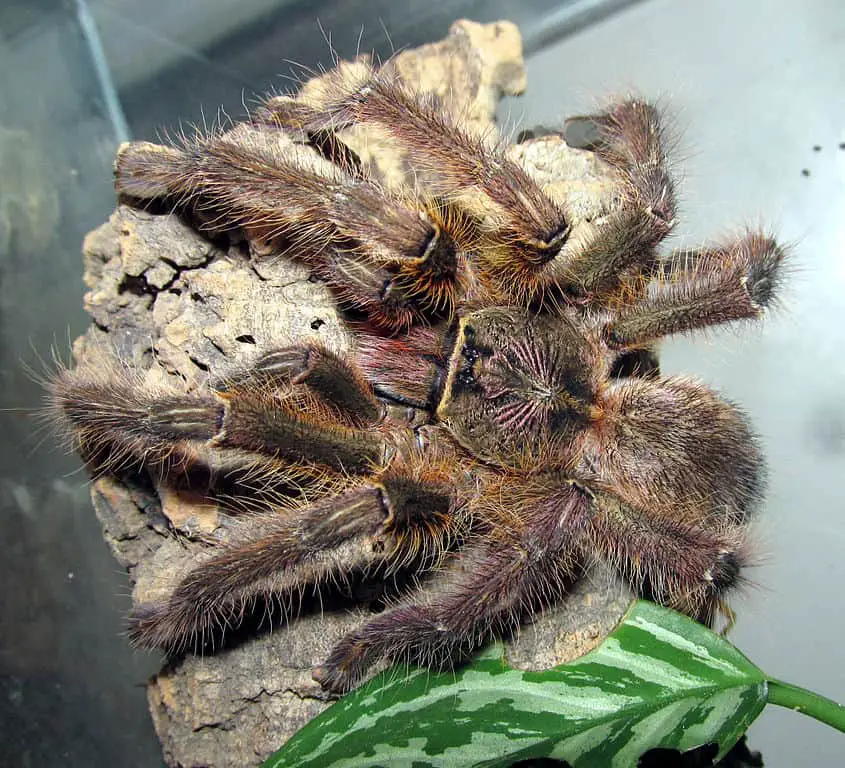
| Category | Old World |
| Type | Arboreal |
| Leg span | 9 to 10 inches |
| Growth speed | Fast |
| Lifespan | Female: 12 years / Male: 3 years |
| Experience level | Advanced |
The Fringed Ornamental Tarantula is a massive arboreal tarantula native to Sri Lanka. Scientifically known as the Poecilotheria ornata, this species is only recommended for experienced hobbyists.
Their venom is extremely painful and they’re not afraid to use it to defend themselves. They will typically strike a threat posture first, but if the threat does not subside they will use their venom defensively. As such, this species is not recommended for beginners and even the most experienced hobbyists should be very careful when interacting with this spider!
However, despite their potent venom and defensive nature, this spider is still quite popular, and for good reason. They’re extremely beautiful to look at and their large size combined with their unique patterns and colors makes them very suitable as display spiders.
7. Xenesthis immanis
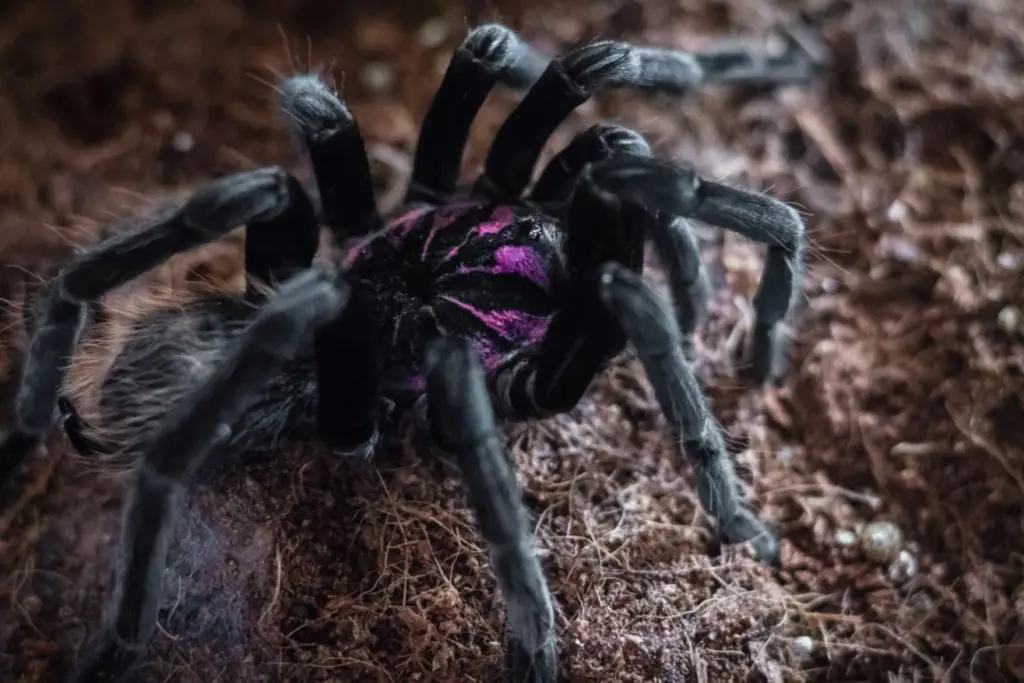
| Category | New World |
| Type | Terrestrial |
| Leg span | 8.5 inches |
| Growth speed | Fast |
| Lifespan | Female: 12 to 15 years / Male: 3 to 4 years |
| Experience level | Intermediate |
The Colombian Lesserblack is an interesting tarantula. Not only because of the fact that it’s big but also because of its symbiotic relationship with the Chiasmocleis ventrimaculata frog in the wild.
In captivity, they’re highly desired as pets because of their large size and beautifully colored pattern on their black body.
Their temperament is quite shy. They tend to run away while kicking urticating hairs whenever they feel threatened. However, they’re not very likely to bite and only do so as a measure of last resort. Luckily, even if you do get bitten, their venom is not all that potent and shouldn’t cause many problems.
They’re quite fast though, so be careful when interacting with them.
8. Pamphobetus sp. Platyomma
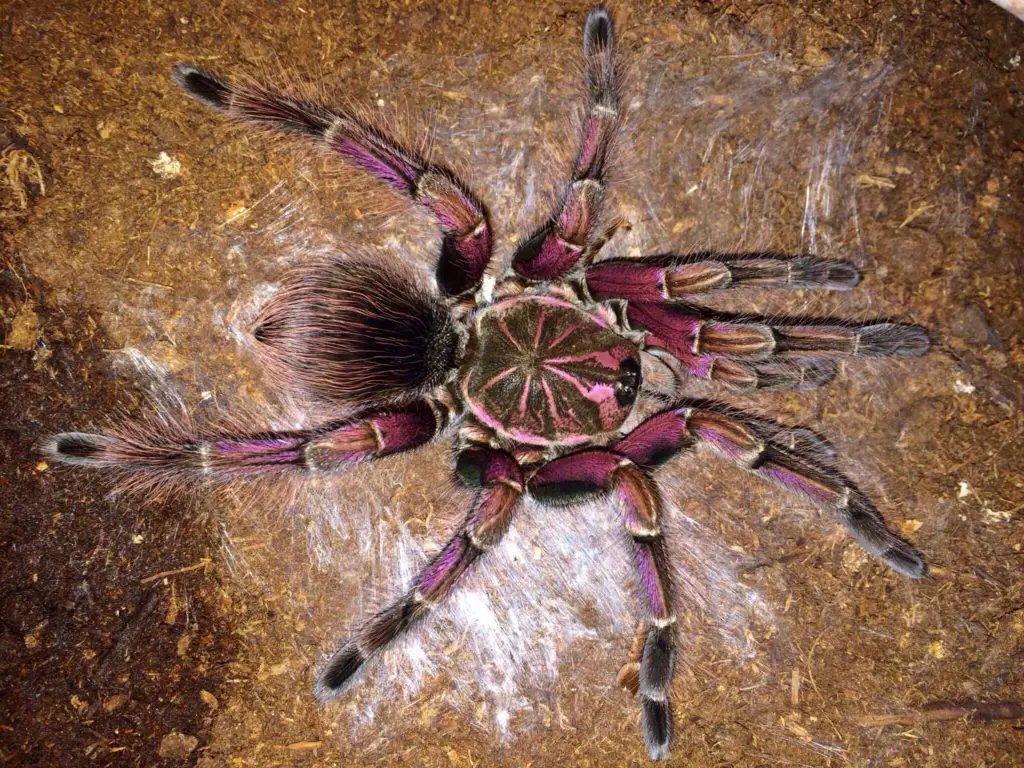
| Category | New World |
| Type | Terrestrial |
| Leg span | 8 inches |
| Growth speed | Medium – Fast |
| Lifespan | Females: 20 years / Males: 4-5 years |
| Experience level | Intermediate |
The Brazilian Pink Bloom tarantula is a marvelous species that is not only known for its large size, but also for its striking coloration. This tarantula truly stands out with its vibrant colors and is highly desired in the pet trade as a result.
They grow to a size of up to 8 inches and females can live for up to 20 years in captivity.
These tarantulas can be quite nervous and tend to retreat when they feel any sort of threat is nearby. When they retreat, they have a tendency to release urticating hairs, so be careful about that.
Due to their shy nature, these spiders are most suitable for intermediate keepers.
9. Grammostola Pulchripes
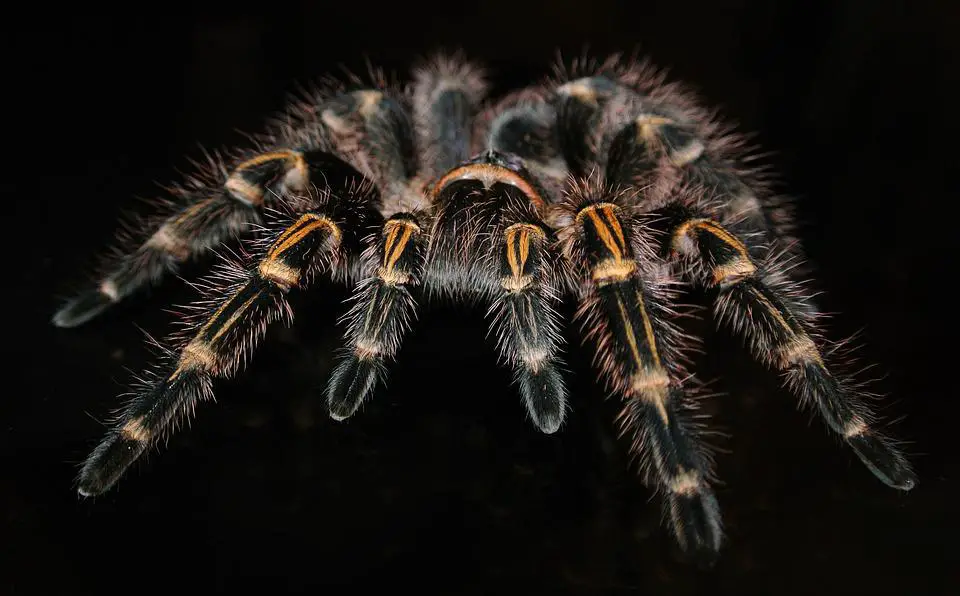
| Category | New World |
| Type | Terrestrial |
| Leg span | 8 inches |
| Growth speed | Medium |
| Lifespan | Female: 20 to 25 years / Male: 5 to 10 years |
| Experience level | Beginner |
The Grammostola Pulchripes is better known as the Chaco Golden Knee Tarantula. It’s one of the most popular species in the hobby, especially for beginners due to its large size, docile temperament, and fascinating looks.
These spiders are mostly black, with interesting yellow markings on their legs that almost look golden (which is where the spider gets its name from).
While these spiders might look intimidating, they’re actually very docile. They almost never bite and you really have to push them in order to get them to show a threat posture. They do have urticating hairs, but they do not release them very often.
On the whole, this species is excellent for beginners!
10. Pelinobius Muticus
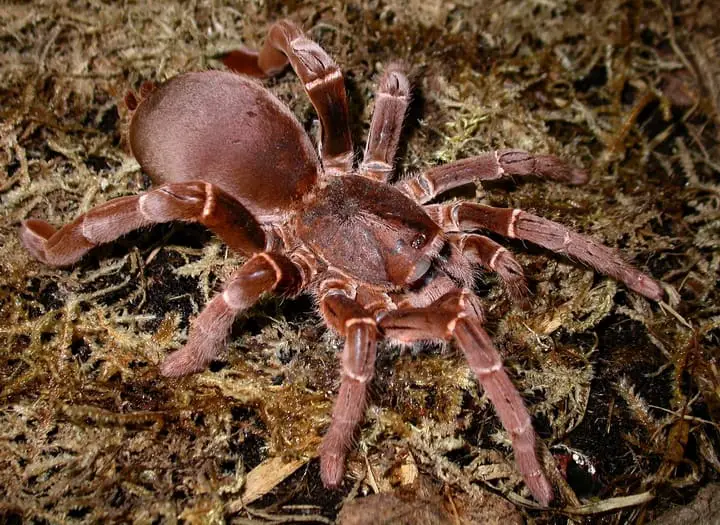
| Category | Old World |
| Type | Terrestrial |
| Leg span | 8 inches |
| Growth speed | Slow |
| Lifespan | Female: 20 to 25 years / Male: 10 to 15 years |
| Experience level | Expert |
While the previous tarantula on this list was very suitable for beginners, the King Baboon Tarantula is anything but beginner-friendly!
These spiders are extremely defensive and have strong fangs and venom to keep threats at bay. They’re very quick to show a threat posture and will bite when provoked. On top of that, they’re extremely fast. All of this means that they’re only suitable for the most experienced keepers, and even they have to be careful when interacting with this species.
They typically grow to a size of around 8 inches and have a lifespan of around 25 years for females.
Final words
So, there you have it, the top 10 biggest tarantulas in the world! With over 800 identified species it’s no surprise that there’s a wide variety between the species. However, people are often still surprised to learn that some species can have a leg span of over 10 inches.
Luckily, the large size of these arachnids does not always mean that they’re dangerous. Some of the species on this list use their size to their advantage and have a defensive temperament, but others are really gentle giants. What this means is that there’s a large tarantula for everyone, whether you’re a beginner or an experienced hobbyist!
If after seeing these big tarantulas you’ve decided that you prefer smaller ones, we’ve got that covered here!
- How Long Do American Eskimo Dogs Live? Important Factors and Care Tips - September 29, 2023
- Do American Bulldogs Need Grooming? Essential Tips and Care Guidelines - September 29, 2023
- Do Bengal Cats Enjoy Playing? Essential Tips for Keeping Them Active - September 29, 2023